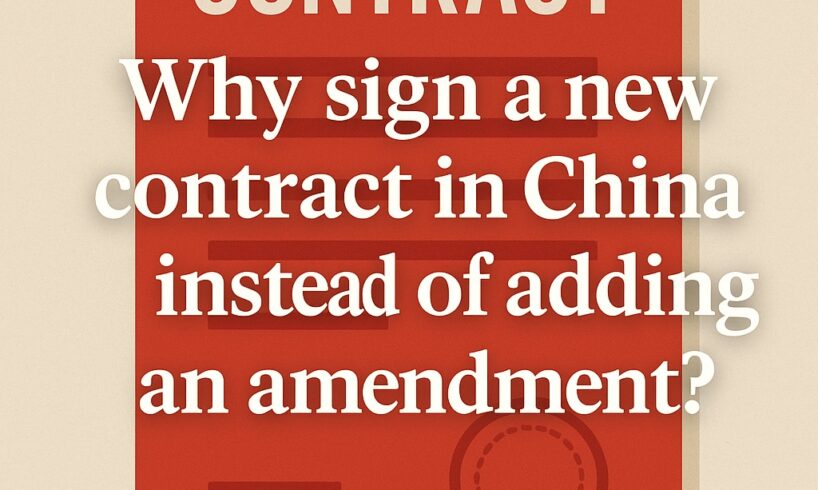
When working with Chinese manufacturers or other counterparties, foreign companies often ask our China business lawyers whether they can amend an existing contract instead of signing a new one. On paper, an amendment sounds efficient. In practice, it usually creates legal and operational risk in China.
The Main Reason: Chinese Courts
Chinese courts prefer one clean, self-contained contract with a clear timeline, complete terms, and a properly applied Chinese company chop. Once you start stacking amendments, you invite confusion about which version controls, whether all pages were chopped, and what the parties actually agreed to.
Not every judge in China is a lawyer or has formal legal training. Many are practical adjudicators focused on moving cases quickly. They do not want to reconstruct a deal from a pile of documents. The simpler and more consolidated your contract, the better your chances of enforcement.
The Practical Risks of China Contract Amendments
Your initial contract may have been solid, but amendments increase the odds of error and ambiguity.
Chop and authenticity issues. If the amendment has a different chop than the original, you create an authenticity problem that can weaken your position.
Arbitration and jurisdiction confusion. If dispute resolution clauses differ between the original and the amendment, a court may apply whichever is most convenient. That unpredictability is bad for business and worse for enforcement.
Language inconsistencies. In bilingual contracts, amendments multiply the risk of divergence between English and Chinese texts. Since Chinese courts usually give priority to the Chinese version, mismatches can lead to outcomes you did not intend.
Outdated compliance terms. China’s regulatory environment changes quickly. Data protection, IP, product standards, tax, and customs rules keep evolving. A new contract lets you reflect current requirements instead of relying on stale language. For example, earlier this year we began structuring our international manufacturing agreements to lawfully reduce tariffs. An amendment rarely accomplishes that and is usually the wrong vehicle to attempt it. If you are revisiting your China manufacturing agreement, drafting a new one is a great opportunity to capture tariff savings.
Why a New China Contract Solves More Than It Complicates
A fresh agreement allows you to reset the relationship on clear and current terms. It is also a practical opportunity to:
Reconfirm your counterparty’s legal name, registration details, address, and bank information, which do change.
Update IP protections, confidentiality provisions, ownership, and licensing.
Tighten pricing, warranties, payment schedules, inspection, and acceptance provisions based on what you have learned since the original deal.
Consolidate everything into one coherent bilingual contract that is internally consistent and easier to enforce.
Chinese banks, tax authorities, and customs officials prefer a single, current contract when reviewing payments, VAT rebates, foreign exchange, and registrations. Providing one document reduces friction and speeds processing.
But Won’t a New Contract Take Longer and Cost More?
This is the first objection we hear, and it is understandable. The reality is that amendments nearly always cost more over time, in hidden ways.
Drafting a new contract can take a few extra hours. Consider what unclear, stacked amendments can cost when:
A dispute arises and your lawyer must reconcile conflicting provisions across multiple documents.
Chinese customs holds a shipment because payment or contract documentation does not match cleanly.
The other side exploits ambiguity that a clean replacement contract would have eliminated, pushing you toward litigation.
A small investment in a clean new contract can save many hours later, along with tens of thousands in legal fees.
The better question is not “Which is faster today?” It is “Which is cheaper when something goes wrong?”
When a China Contract Amendment Is Acceptable
Amendments can work for narrow, mechanical changes. Extending a delivery date or adjusting a unit price within an existing formula can be handled by amendment if you:
Reference the original agreement precisely by title and date.
Restate the changed clause in full and attach any updated schedule.
Apply the same company chop on each page of the amendment.
Keep the original structure intact, including dispute resolution and language hierarchy.
For any material change in scope, pricing structure, party identity, or risk allocation, a new bilingual contract with proper chops is safer, cleaner, and more enforceable.
Key Takeaways
Chinese courts value clarity and a single, self-contained agreement.
Stacked amendments create ambiguity, chop problems, and evidentiary risk.
Use a new contract when anything material changes.
Keep compliance current by refreshing terms to reflect today’s rules.
Reserve amendments for minor, mechanical tweaks only.
Final Thoughts
This topic came from a client question that prompted a deeper internal discussion among my law firms China contract lawyers and ultimately this post.
It is a good reminder that in China, legal simplicity is almost always the best strategy for getting the outcome you expect when something goes wrong.





